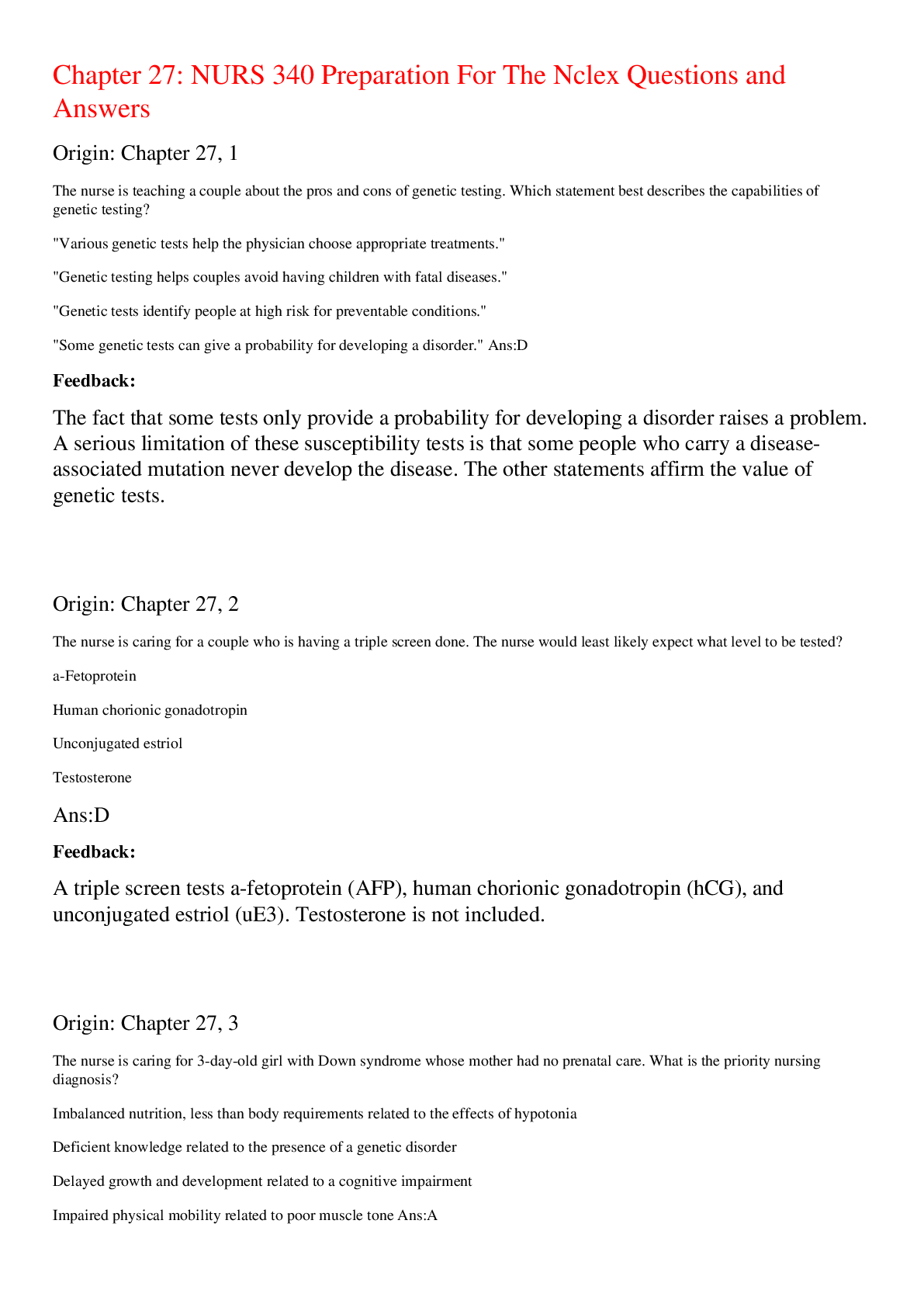*NURSING > TEST BANK > NURS 340 Preparation For The Nclex Questions and Answers Test Bank ,100% CORRECT (All)
NURS 340 Preparation For The Nclex Questions and Answers Test Bank ,100% CORRECT
Document Content and Description Below
NURS 340 Preparation For The Nclex Questions and Answers Test Bank Origin: Chapter 4, 1 1. The nurse is performing a physical assessment of a 3-year-old girl. What finding would be a concern for ... the nurse? A) The toddler gained 4 pounds in weight since last year. B) The toddler gained 3 inches in height since last year. C) The toddler's anterior fontanel is not fully closed. D) The circumference of the child's head increased 1 inch since last year. Ans: C Feedback: The anterior fontanel should be closed by the time the child is 18-months old. The average toddler weight gain is 3 to 5 pounds per year. Length/height increases by an average of 3 inches per year. Head circumference increases about 1 inch from when the child is between 1 and 2 years of age, then increases an average of a half-inch per year until age 5. Origin: Chapter 4, 2 2. The nurse is describing the maturation of various organ systems during toddlerhood to the parents. What would the nurse correctly include in this description? A) Myelinization of the brain and spinal cord is complete at about 24 months. B) Alveoli reach adult numbers by 3 years of age. C) Urine output in a toddler typically averages approximately 30 mL/hour. D) Toddlers typically have strong abdominal muscles by the age of 2. Ans: A Feedback: Myelinization of the brain and spinal cord continues to progress and is complete around 24 months of age. Alveoli reach adult numbers usually around the age of 7. Urine output in a toddler typically averages 1 mL/kg/hour. Abdominal musculature in a toddler is weak, resulting in a pot-bellied appearance. Origin: Chapter 4, 3 3. The nurse is teaching the parents of a 2-year-old toddler methods of dealing with their child's 'negativism.' Based on Erickson's theory of development, what would be an appropriate intervention for this child? A) Discourage solitary play; encourage playing with other children. B) Encourage the child to pick out his own clothes. C) Use 'time-outs' whenever the child says 'no' inappropriately. D) Encourage the child to take turns when playing games. Ans: B Feedback: Erikson defines the toddler period as a time of autonomy versus shame and doubt. It is a time of exerting independence. Allowing the child to choose his own clothes helps him to assert his independence. Negativism and always saying "no" is a normal part of healthy development and is occurring as a result of the toddler's attempt to assert his or her independence. It should not be punished with 'time-outs.' The toddler should be encouraged to play alone and with other children. Toddlers cannot take turns in games until age 3. Origin: Chapter 4, 4 4. The nurse is caring for a toddler who is in Piaget's sensorimotor stage of cognitive development. Which task would the nurse expect the toddler to be able to perform? A) Completing puzzles with four pieces B) Winding up a mechanical toy C) Playing make-believe with dolls D) Knowing which are his or her toys Ans: D Feedback: The toddler in Piaget's sensorimotor stage of cognitive development (18 to 24 months) understands requests, is capable of following simple directions, and has a sense of ownership (knowing which toys are his). The other tasks are accomplished by the child in the preoperational stage (2 to 7 years). Origin: Chapter 4, 5 5. The nurse is observing a 24-month-old boy in a day care center. Which finding suggests delayed motor development? A) The child has trouble undressing himself. B) The child is unable to push a toy lawnmower. C) The child is unable to unscrew a jar lid. D) The child falls when he bends over. Ans: B Feedback: Children with normal motor development are able to push toys with wheels at 24 months of age. He won't be ready to undress himself, unscrew a jar lid, or bend over without falling until about 36 months of age. Origin: Chapter 4, 6 6. What activity would the nurse expect to find in an 18-month-old? A) Standing on tiptoes B) Pedaling a tricycle C) Climbing stairs with assistance D) Carrying a large toy while walking Ans: C Feedback: Toddlers continue to progress with motor skills. An 18-month-old should be able to climb stairs with assistance. A 24-month-old should be able to stand on his or her tiptoes and carry a large toy while walking. A 36-month-old would be able to pedal a tricycle. Origin: Chapter 4, 7 7. The pediatric nurse is planning quiet activities for hospitalized 18-month-old. What would be an appropriate activity for this age group? A) Painting by number B) Putting shapes into appropriate holes C) Stacking blocks D) Using crayons to color in a coloring book Ans: C Feedback: At 18 months the child can stack four blocks. The 24-month-old can paint (but not by number), scribble, and color, and put round pegs into holes. Origin: Chapter 4, 8 8. The nurse is performing a cognitive assessment of a 2-year-old. Which behavior would alert the nurse to a developmental delay in this area? A) The child cannot say name, age, and gender. B) The child cannot follow a series of two independent commands. C) The child has a vocabulary of 40 to 50 words. D) The child does not point to named body parts. Ans: D Feedback: The 2-year-old can point to named body parts and has a vocabulary of 40 to 50 words. At 30 months old a child can follow a series of two independent commands and at 3-years old a child can say name, age, and gender. Origin: Chapter 4, 9 9. The nurse is interviewing a 3-year-old girl who tells the nurse: 'Want go potty.' The parents tell the nurse that their daughter often speaks in this type of broken speech. What would be the nurse's appropriate response to this concern? A) 'This is a normal, common speech pattern in the 3-year-old and is called telegraphic speech.' B) 'This is considered a developmental delay in the 3-year-old and we should consult a speech therapist.' C) 'This is a condition known as echolalia and can be corrected if you work with your daughter on language skills.' D) 'This is a condition known as stuttering and it is a normal pattern of speech development in the toddler.' Ans: A Feedback: Telegraphic speech is common in the 3-year-old. Telegraphic speech refers to speech that contains only the essential words to get the point across, much like a telegram. In telegraphic speech the nouns and verbs are present and are verbalized in the appropriate order. Echolalia (repetition of words and phrases without understanding) normally occurs in toddlers younger than 30 months of age. "Why" and "what" questions dominate the older toddler's language. Stuttering usually has its onset at between 2 and 4 years of age. It occurs more often in boys than in girls. About 75% of all cases of stuttering resolve within 1 to 2 years after they start. Origin: Chapter 4, 10 10. After teaching a group of parents about language development in toddlers, what if stated by a member of the group indicates successful teaching? A) "When my 3-year-old asks 'why?' all the time, this is completely normal." B) "A 15-month-old should be able to point to his eyes when asked to do so." C) "At age 2 years, my son should be able to understand things like under or on." D) "An 18-month-old would most likely use words and gestures to communicate." Ans: A Feedback: Language development occurs rapidly in a toddler. By age 3 years, the child asks "why?" Pointing to named body parts is characteristic of a 2-year-old. Understanding concepts such as on, under, or in is typical of a 3-year-old. A 1-year-old would communicate with words and gestures. Origin: Chapter 4, 11 11. The nurse is testing the sensory development of a toddler brought to the clinic for a well visit. What might alert the nurse to a potential problem with the child's sensory development? A) The toddler places the nurse's stethoscope in his mouth. B) The toddler's vision tests at 20/50 in both eyes. C) The toddler does not respond to commands whispered in his ear. D) The toddler's taste discrimination is not at adult levels yet. Ans: C Feedback: Hearing should be at the adult level, as infants are ordinarily born with hearing intact. Therefore, the toddler should hear commands whispered in his ear. Toddlers examine new items by feeling them, looking at them, shaking them to hear what sound they make, smelling them, and placing them in their mouths. Toddler vision continues to progress and should be 20/50 to 20/40 in both eyes. Though taste discrimination is not completely developed, toddlers may exhibit preferences for certain flavors of foods. Origin: Chapter 4, 12 12. The nurse observing toddlers in a day care center notes that they may be happy and pleasant one moment and overreact to limit setting the next minute by throwing a tantrum. What is the focus of the toddler's developmental task that is driving this behavior? A) The need for separation and control B) The need for love and belonging C) The need for safety and security D) The need for peer approval Ans: A Feedback: Emotional development in the toddler years is focused on separation and individuation. The focus in infancy is on love and belonging, and the need for peer approval occurs in the adolescent. Safety and security are concerns in all levels of development, but not the primary focus. Origin: Chapter 4, 13 13. The nurse is teaching parents interventions appropriate to the emotional development of their toddlers. What is a recommended intervention for this age group? A) Remove children's security blankets at this stage to help them assert their autonomy. B) Distract toddlers from exploring their own body parts, particularly their genitals. C) Do not blame toddlers for aggressive behavior; instead, point out the results of their behavior. D) Offer toddlers many choices to foster control over their environment. Ans: C Feedback: Toddlers should not be blamed for their aggressive behavior; adults can assist the toddler in building empathy by pointing out when someone is hurt and explaining what happened. Adults should allow toddlers to rely upon a security item to self-soothe as this is a function of autonomy and is viewed as a sign of a nurturing environment, rather than one of neglect. Toddlers may question parents about the difference between male and female body parts and may begin to explore their own genitals. This is normal behavior in this age group. Offering limited choices is one way of allowing toddlers some control over their environment and helping them to establish a sense of mastery. Origin: Chapter 4, 14 14. The nurse is assessing a 3-year-old boy's development during a well-child visit. Which response by the child indicates the need for further assessment? A) He says a swear word when he hurts himself playing. B) He says "pew" when his sister has soiled her diaper. C) He laughs when his brother cries getting vaccinated. D) He constantly asks "why?" whenever he is told a fact. Ans: C Feedback: Laughing when his brother cries when being vaccinated indicates that the child hasn't yet developed a sense of empathy or that there may be psychosocial issues, such as sibling rivalry, that should be assessed. The child may repeat a word even if it is out of context. This is called echolalia. Older toddlers have a well-developed sense of smell and will comment if they don't like a smell. The incessant "why" is very common to toddlers' speech. Origin: Chapter 4, 15 15. The nurse is designing a nursing care plan for a toddler with lymphoma, who is hospitalized for treatment. What is a priority intervention that the nurse should include in this child's nursing plan? A) Limiting visitors to scheduled visiting hours B) Planning physical therapy for the child C) Introducing the toddler to other toddlers in the unit D) Monitoring the toddler for developmental delays Ans: D Feedback: When the toddler is hospitalized, growth and development may be altered. The toddler's primary task is establishing autonomy, and the toddler's focus is mobility and language development. The nurse caring for the hospitalized toddler must use knowledge of normal growth and development to be successful in interactions with the toddler, promote continued development, and recognize delays. Parents should be encouraged to stay with the toddler to avoid separation anxiety. Planning activities and socialization of the toddler is important, but the priority intervention is monitoring for, and addressing, developmental delays that may occur in the hospital. Origin: Chapter 4, 16 16. The nurse is watching toddlers at play. Which normal behavior would the nurse observe? A) Toddlers engage in parallel play. B) Toddlers engage in solitary play. C) Toddlers engage in cooperative play. D) Toddlers do not engage in play outside the home. Ans: A Feedback: Toddlers typically play alongside another child (parallel play) rather than cooperatively. Infants engage in solitary play. Origin: Chapter 4, 17 17. The nurse is developing a teaching plan for toddler safety to present at a parenting seminar. Which safety intervention should the nurse address? A) Encourage parents to enroll toddlers in swimming classes to avoid the need for constant supervision around water. B) Advise parents to keep pot handles on stoves turned outward to avoid accidental burns. C) Encourage parents to smoke only in designated rooms in the house or outside the house. D) Advise parents to use a forward-facing car seat with harness straps and a clip, placed in the backseat of the car. Ans: D Feedback: Safety is of prime concern throughout the toddler period. The safest place for the toddler to ride is in the back seat of the car. Parents should use the appropriate size and style of car seat for the child's weight and age as required by the state. At a minimum, all children over 20 pounds and up to 40 pounds should be in a forward-facing car seat with harness straps and a clip. Parents who want to enroll a toddler in a swimming class should be aware that a water safety skills class would be most appropriate. However, even toddlers who have completed a swimming program still need constant supervision in the water. Pot handles on stoves should be turned inward to avoid accidental burn. Nurses should counsel parents to stop smoking (optimal), but if they continue smoking never to smoke inside the home or car with children present. Origin: Chapter 4, 18 18. During a health history, the nurse explores the sleeping habits of a 3-year-old boy by interviewing his parents. Which statement from the parents reflects a recommended guideline for promoting healthy sleep in this age group? A) 'Our son sleeps through the night, and we insist that he takes two naps a day.' B) 'We keep a strict bedtime ritual for our son, which includes a bath and bedtime story.' C) 'Our son still sleeps in a crib because we feel it is the safest place for him at night.' D) 'Our son occasionally experiences night walking so we allow him to stay up later when this happens.' Ans: B Feedback: Consistent bedtime rituals help the toddler prepare for sleep; the parent should be advised to choose a bedtime and stick to it as much as possible. The nightly routine might include a bath followed by reading a story. A typical toddler should sleep through the night and take one daytime nap. Most children discontinue daytime napping at around 3 years of age. When the crib becomes unsafe (that is, when the toddler becomes physically capable of climbing over the rails), then he or she must make the transition to a bed. Attention during night waking should be minimized so that the toddler receives no reward for being awake at night. Origin: Chapter 4, 19 19. The nurse is teaching good sleep habits for toddlers to the mother of a 3-year-old boy. Which response indicates the mother understands sleep requirements for her son? A) "I'll put him to bed at 7 p.m., except Friday and Saturday." B) "He needs 12 hours of sleep per day including his nap." C) "I need to put the side down on the crib so he can get out." D) "His father can give him a horseback ride into his bed." Ans: B Feedback: The mother understands her child needs 12 hours of sleep and one nap per day. Routines, such as the same bedtime every night, promote good sleep. However, a horseback ride to bed may cause problems because it may not provide a calming transition from play to sleep. A bath and reading a book would be better. If the child can climb out of a crib, he needs to be in a youth bed or regular bed to avoid injury. Origin: Chapter 4, 20 20. The parents of a 1-year-old girl, both of whom have perfect teeth, are concerned about their child getting dental caries. Which is the best advice the nurse can provide? A) Tell the parents to limit the child's eating to meal and snack times. B) Urge the parents to take the child to a dentist for a check-up. C) Advise the parents to reduce carbohydrates in the child's diet. D) Advise the parents to use fluoride toothpaste. Ans: A Feedback: Telling the parents to limit eating to meal and snack times is the best advice for preventing dental caries. This reduces the amount of exposure the child's teeth have to food. Urging them to take the child to see a dentist is sound advice but doesn't suggest actions they can take now to prevent caries. Carbohydrates react with oral bacteria to cause caries, but they should not be reduced from the diet. Avoiding fluoridated toothpaste may help prevent fluorosis. Origin: Chapter 4, 21 21. The nurse is helping parents prepare a healthy meal plan for their toddler. Which guidelines for promoting nutrition should be followed when planning meals? Select all that apply. A) The child younger than 2 years of age should have his or her fat intake restricted. B) Extending breastfeeding into toddlerhood is believed to be beneficial to the child. C) Weaning from the bottle should occur by 6 to 12 months of age. D) Adequate calcium intake and appropriate exercise lay the foundation for proper bone mineralization. E) The toddler requires an average intake of 500 mg calcium per day. F) Toddlers tend to have the highest daily iron intake of any age group. Ans: B, D, E Feedback: Extending breastfeeding into toddlerhood is believed to be beneficial to the child as it is known to help prevent obesity. Adequate calcium intake and appropriate exercise lay the foundation for proper bone mineralization. The toddler requires an average intake of 500 mg calcium per day. The child younger than 2 years of age should not have his or her fat intake restricted, but this does not mean that unhealthy foods such as sweets should be eaten liberally. Weaning from the bottle should occur by 12 to 15 months of age. Prolonged bottle-feeding is associated with the development of dental caries. It is important for toddlers to consume adequate amounts of iron since they tend to have the lowest daily iron intake of any age group. Origin: Chapter 4, 22 22. The nurse is choosing foods for a toddler's diet that are high in vitamin A. What foods could be added to the menu? Select all that apply. A) Applesauce B) Avocados C) Broccoli D) Sweet potatoes E) Spinach F) Carrots Ans: D, E, F Feedback: Foods that are high in vitamin A include apricots, cantaloupe, carrots, mangos, spinach and dark greens, and sweet potatoes. Applesauce is high in fiber, and avocados and broccoli are high in folate. Origin: Chapter 4, 23 23. When instructing the parents of a toddler about appropriate nutrition, what would the nurse recommend? A) About 12 to 16 ounces of fruit juice per day B) Approximately 16 to 24 ounces of milk per day C) Fat intake of 30% to 40% of total calories D) An average of 10 to 12 grams of fiber per day Ans: B Feedback: Milk intake should be limited to 16 to 24 ounces per day, with fruit juice limited to 4 to 6 ounces per day. A toddler's total fat intake should be 20% to 30% of total calories. The daily recommended fiber intake is 19 grams. Origin: Chapter 4, 24 24. The nurse is teaching the parents of an overweight 18-month-old girl about diet. Which intervention will be most effective for promoting proportionate growth? A) Remove high-calorie, low-nutrient foods from the diet. B) Ensure 30 minutes of unstructured activity per day. C) Avoid sharing your snacks and candy with the child. D) Reduce the amount of high-fat food the child eats. Ans: A Feedback: The most effective intervention will be to remove high-calorie, low-nutrient foods from the diet in order to reduce the number of calories and increase the nutritional value. Exercise is also important, but a child this age should have 30 minutes of structured physical activity plus several hours of unstructured physical activity per day. The parents should set an example for good eating habits. Dietary fat should not be restricted for an 18-month-old child because it is necessary for nervous system development. Origin: Chapter 4, 25 25. The nurse is providing anticipatory guidance to the parents of an 18-month-old girl. Which guidance will be most helpful for toilet teaching? A) Telling them either one may demonstrate toilet use B) Assuring them that bladder control occurs first C) Telling them that curiosity is a sure sign of readiness D) Advising them to use praise, not scolding Ans: D Feedback: The most helpful guidance for toilet teaching is to urge the parents to use only praise, but never to scold, throughout the process. It is best for the same-sex parent to demonstrate toilet use. Bowel control will occur first. It may take additional months for nighttime bladder control to be achieved. Curiosity is a sign of readiness for toilet teaching, but by no means a sure sign. Origin: Chapter 4, 26 26. The parents of a 2-year-old girl are frustrated by the frequent confrontations they have with their child. Which is the best anticipatory guidance the nurse can offer to prevent confrontations? A) "Respond in a calm but firm manner." B) "You need to adhere to various routines." C) "Put her in time-out when she misbehaves." D) "It's important to toddler-proof your home." Ans: B Feedback: Making expectations known through everyday routines helps to avoid confrontations. This helps the child know what to expect and how to behave. It is the best guidance to give these parents. Calm response and time-out are effective ways to discipline, but do not help to prevent confrontations. Toddler-proofing the house doesn't eliminate all the opportunities for confrontation. Origin: Chapter 4, 27 27. The nurse is providing guidance after observing a mother interact with her negative 2- year-old boy. For which interaction will the nurse advise the mother that she is handling the negativism properly? A) Telling the child to stop tearing pages from magazines B) Asking the child if he would please quit throwing toys C) Telling the child firmly that we don't scream in the office D) Saying, "Please come over here and sit in this chair. OK?" Ans: C Feedback: Telling the child firmly that we don't scream in the office gets the point across to the child that his behavior is unacceptable while role modeling appropriate communication. Telling the child to stop tearing up magazines does not give him direction for appropriate behavior. Asking the child if he would quit throwing toys gives him an opportunity to say "no," and is the same as asking "OK?" at the end of a direction. Origin: Chapter 4, 28 28. The nurse is teaching the parents of a 2-year-old girl how to deal with common toddler situations. Which is the best advice? A) Discipline the child for regressive behavior. B) Scold the child for public thumb sucking. C) Tell the older sibling to not act like a baby. D) Have the child help clean up a bowel accident. Ans: D Feedback: Having the child help clean up a bowel accident is the best advice. Toddlers should never be punished for bowel or bladder "accidents," but gently reminded about toileting. Regressive behavior is best ignored, while appropriate behavior should be praised. Telling the older sibling to not act like a baby is a negative approach. It would be better to have the child be mother's helper. Calmly telling the child that thumb sucking is something that is done at home is better than scolding the child. Origin: Chapter 4, 29 29. The nurse is assessing a 2-year-old boy who has missed some developmental milestones. Which finding will point to the cause of motor skill delays? A) The mother is suffering from depression. B) The child is homeless and has no toys. C) The mother describes an inadequate diet. D) The child is unperturbed by a loud noise. Ans: B Feedback: Children develop through play, so a child without any toys may have trouble developing the motor skills appropriate to his age. Maternal depression is a risk factor for poor cognitive development. Inadequate diet will cause growth deficiencies. A child who does not respond to a loud noise probably has hearing loss, which will lead to a language deficit. Origin: Chapter 4, 30 30. The nurse emphasizes that a toddler younger than the age of 18 months should never be spanked primarily for which reason? A) Spanking in a child this age predisposes the child to a pro-violence attitude. B) The child will become resentful and angry, leading to more outbursts. C) Spanking demonstrates a poor model for problem-solving skills. D) There is an increased risk for physical injury in this age group. Ans: D Feedback: Spanking should never be used with toddlers younger than 18 months of age because there is an increased possibility of physical injury. Although spanking or other forms of corporal punishment lead to a pro-violence attitude, create resentment and anger in the child, and are a poor model for learning effective problem-solving skills, the risk of physical injury in this age group is paramount. [Show More]
Last updated: 1 year ago
Preview 1 out of 14 pages
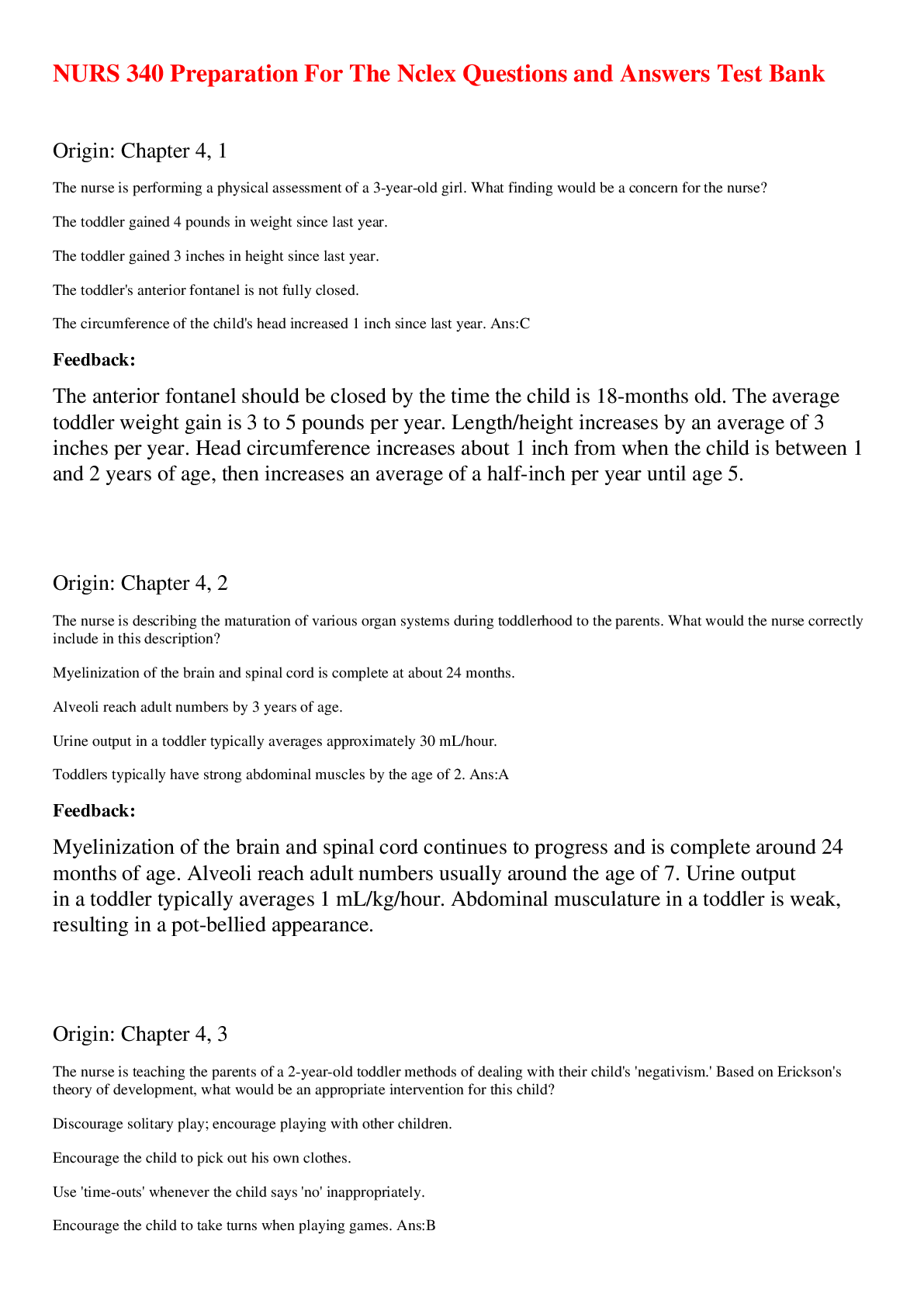
Reviews( 0 )
Document information
Connected school, study & course
About the document
Uploaded On
Feb 13, 2023
Number of pages
14
Written in
Additional information
This document has been written for:
Uploaded
Feb 13, 2023
Downloads
0
Views
39

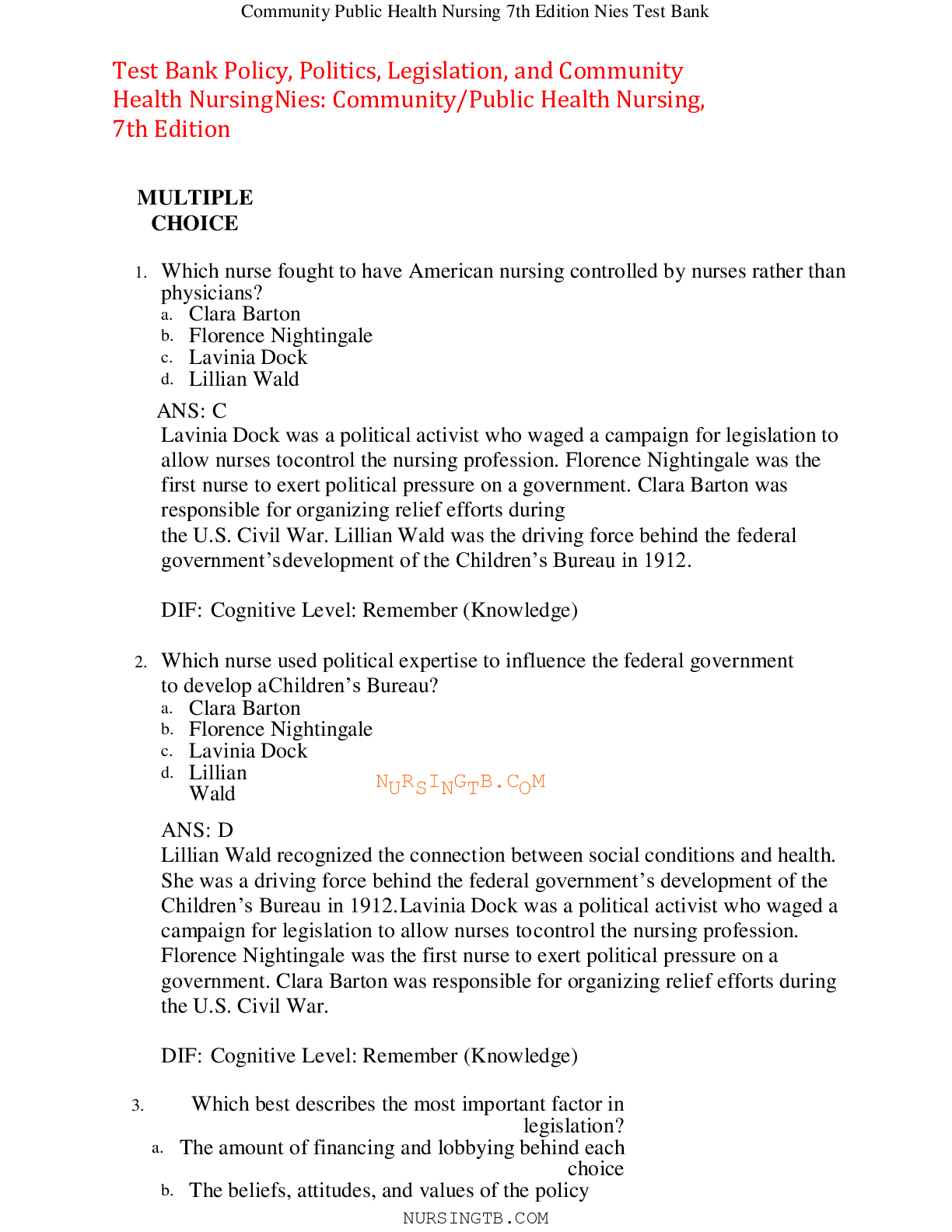


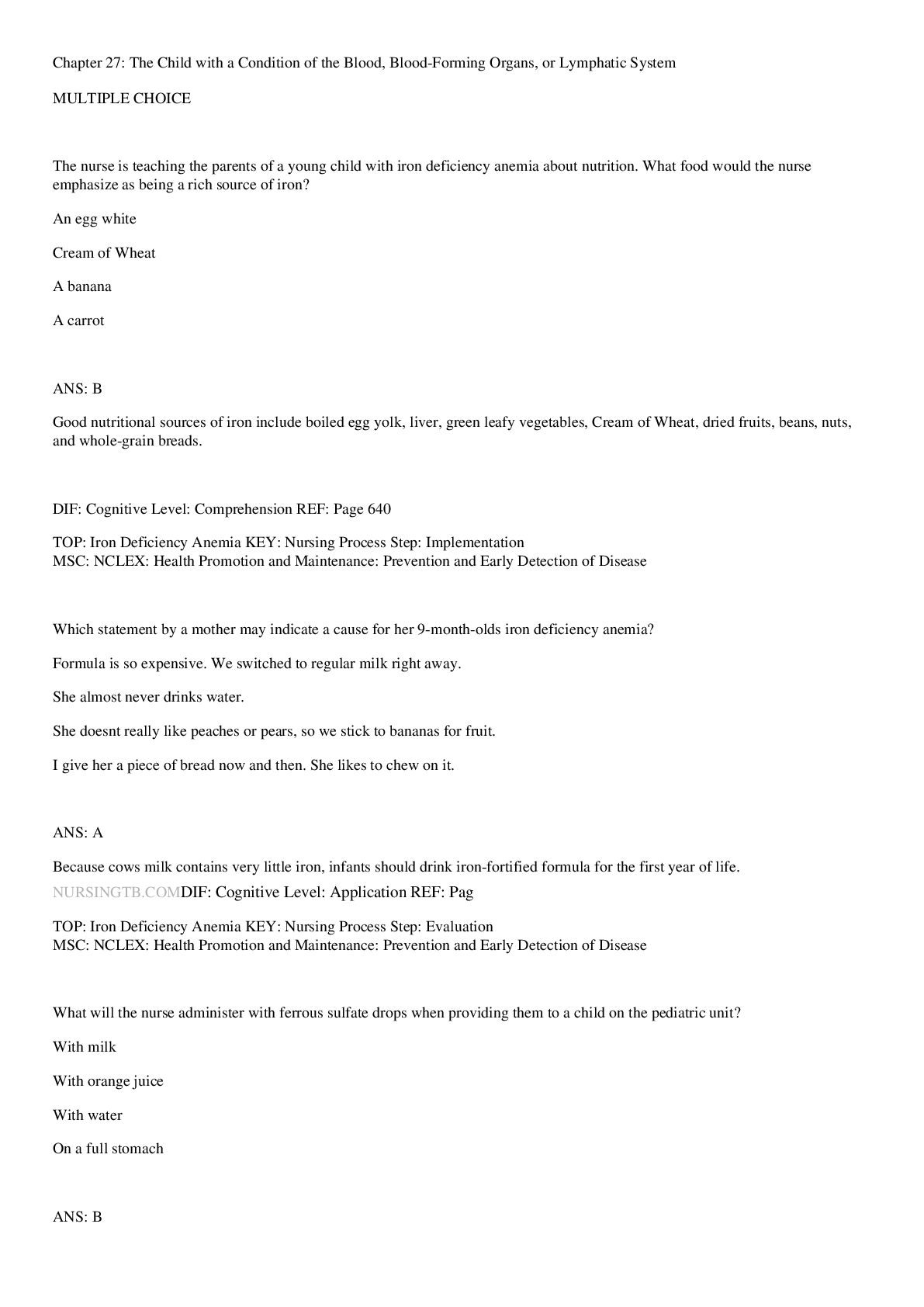



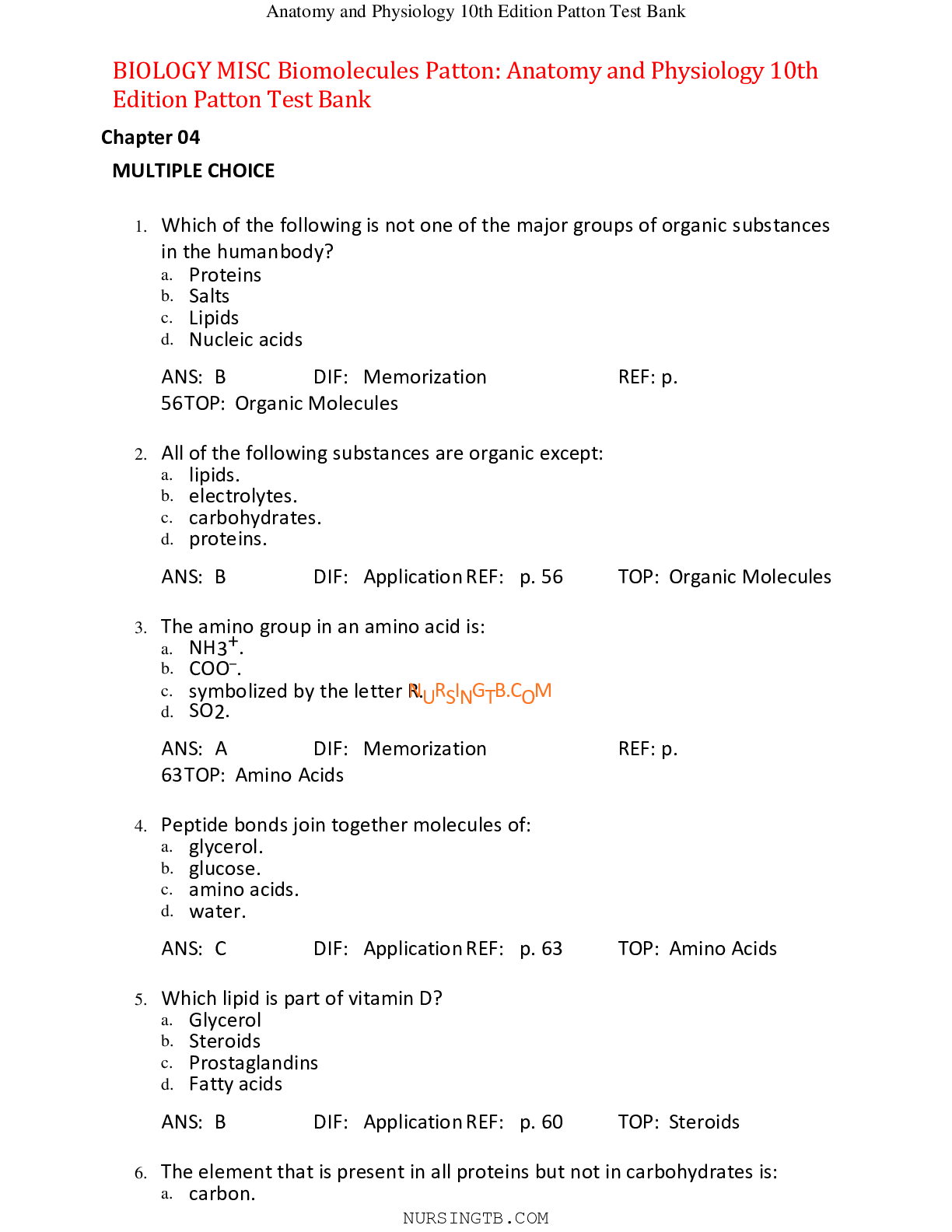







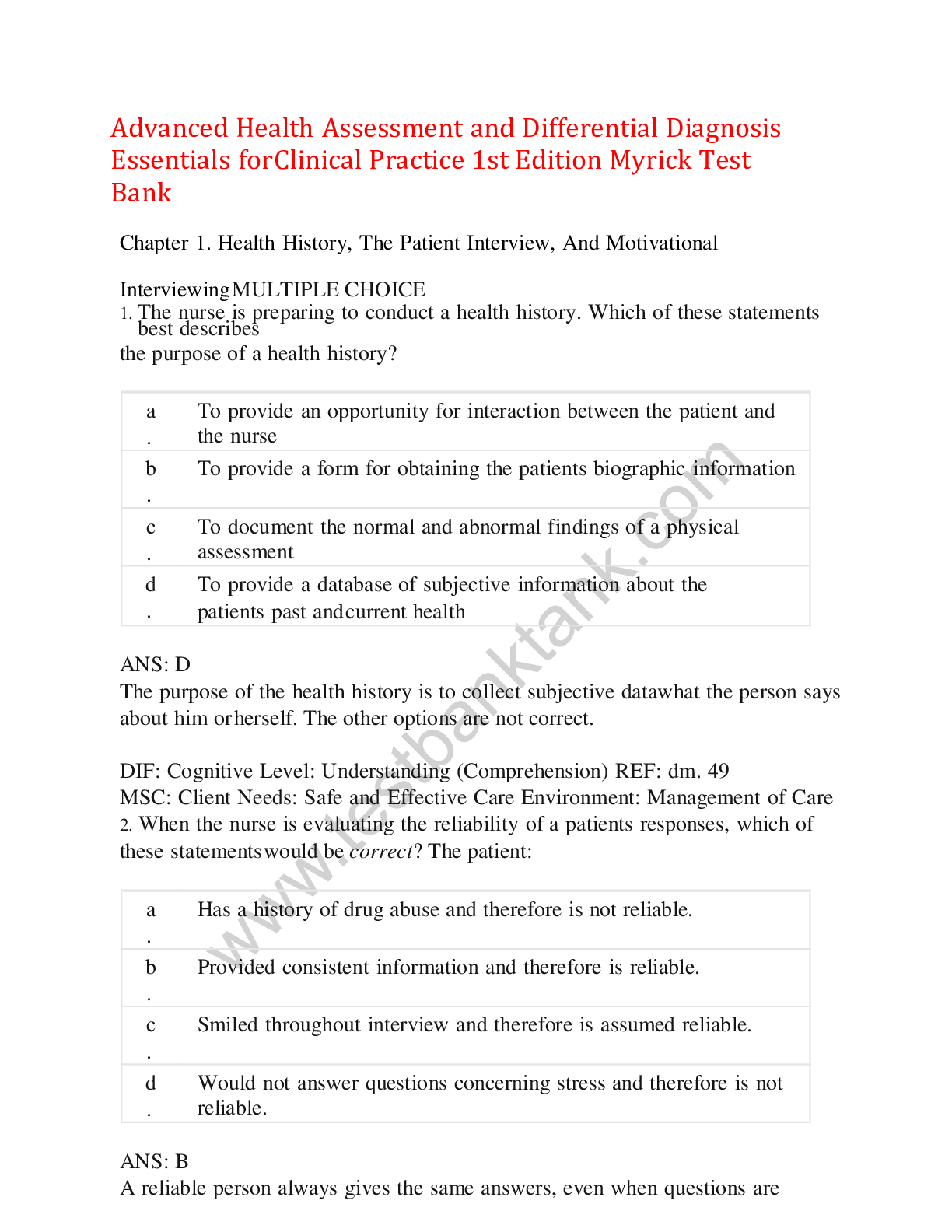


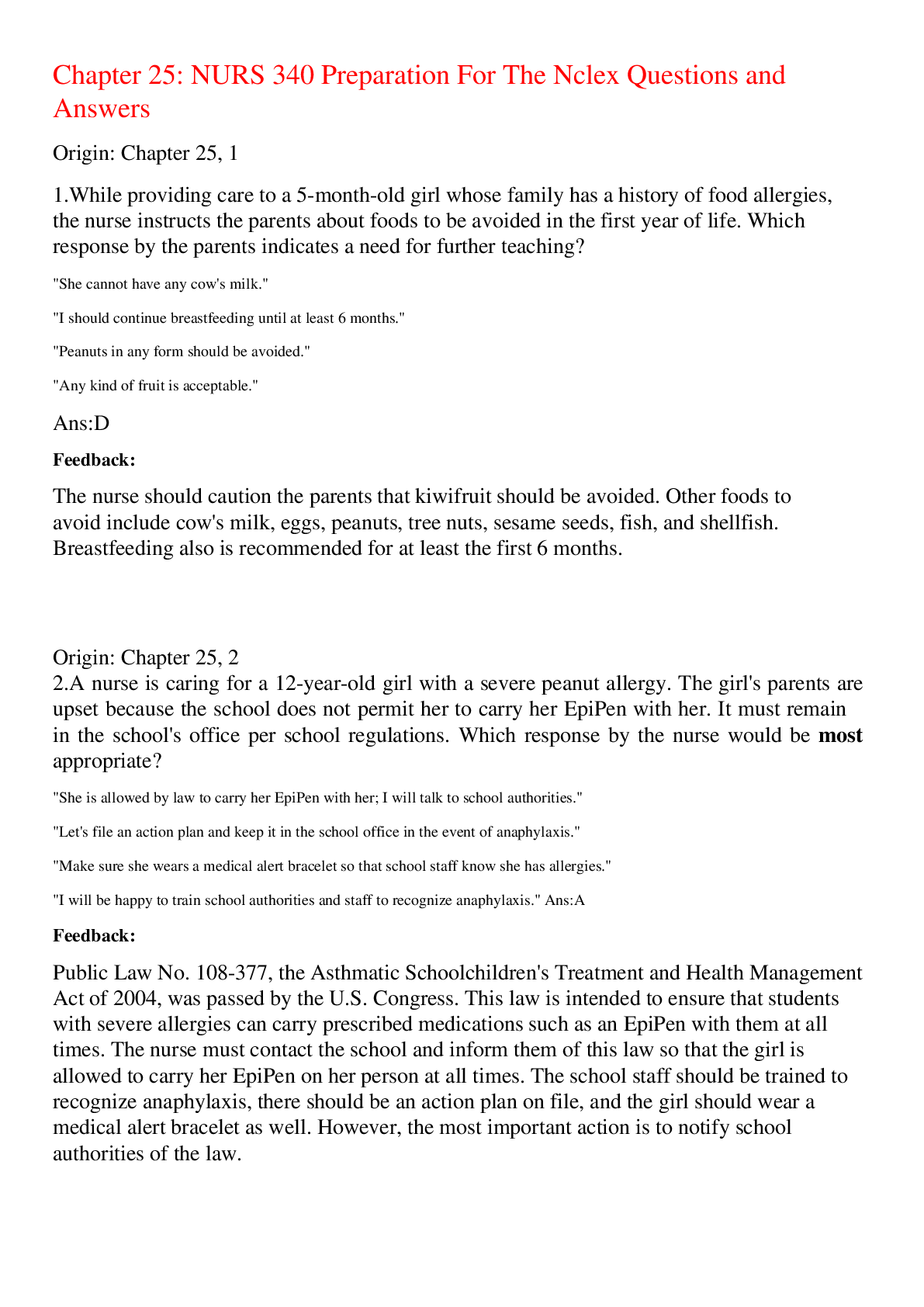
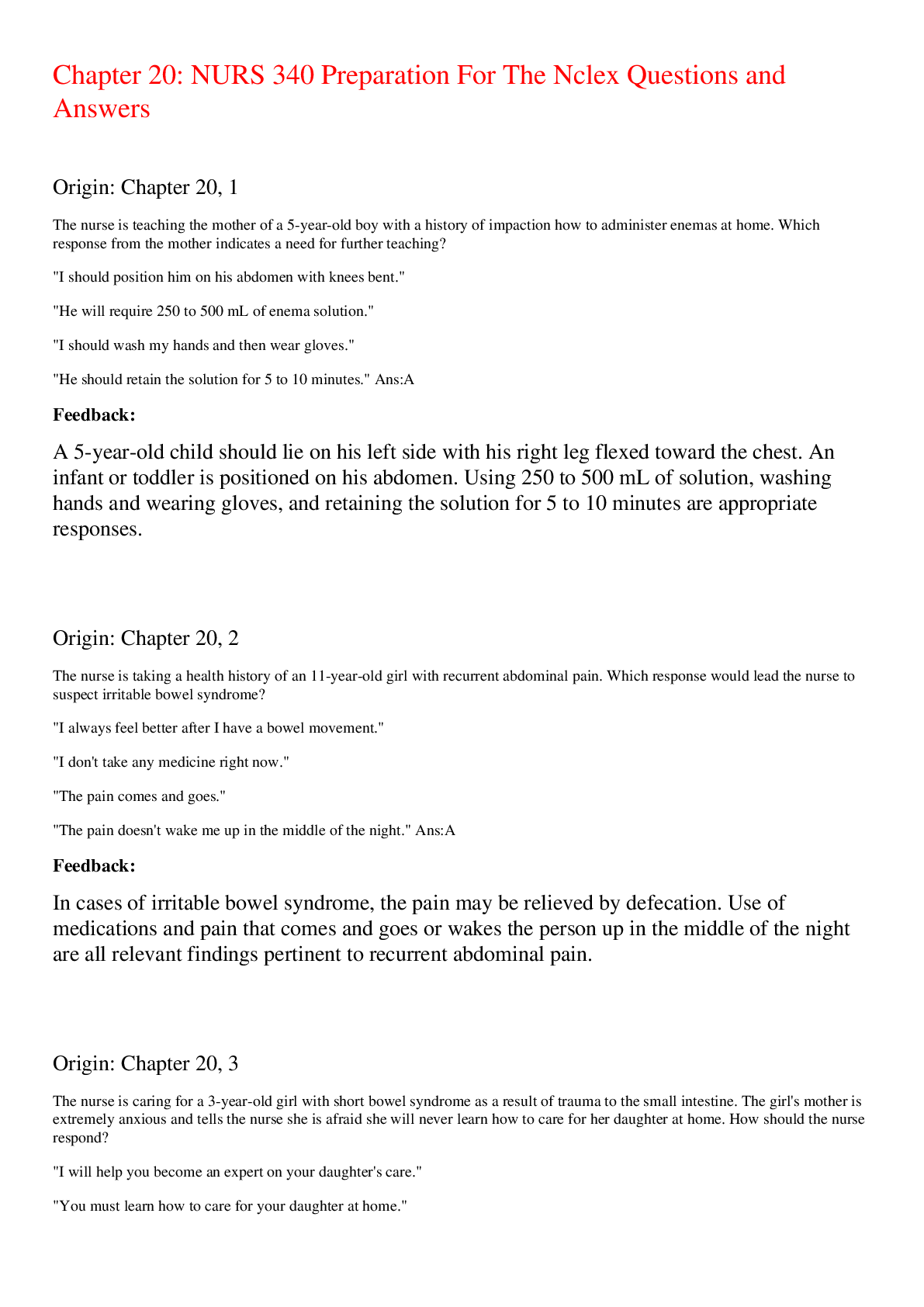
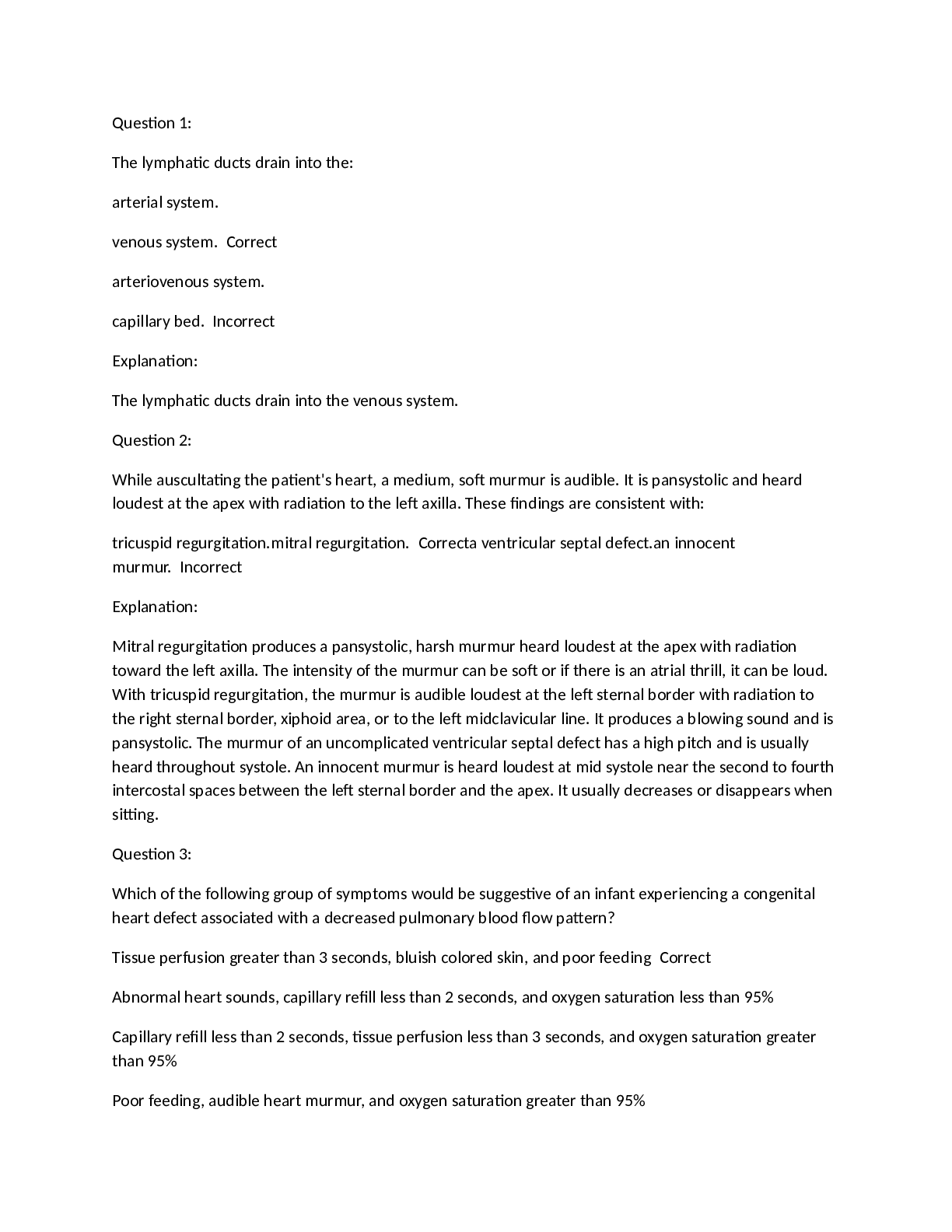
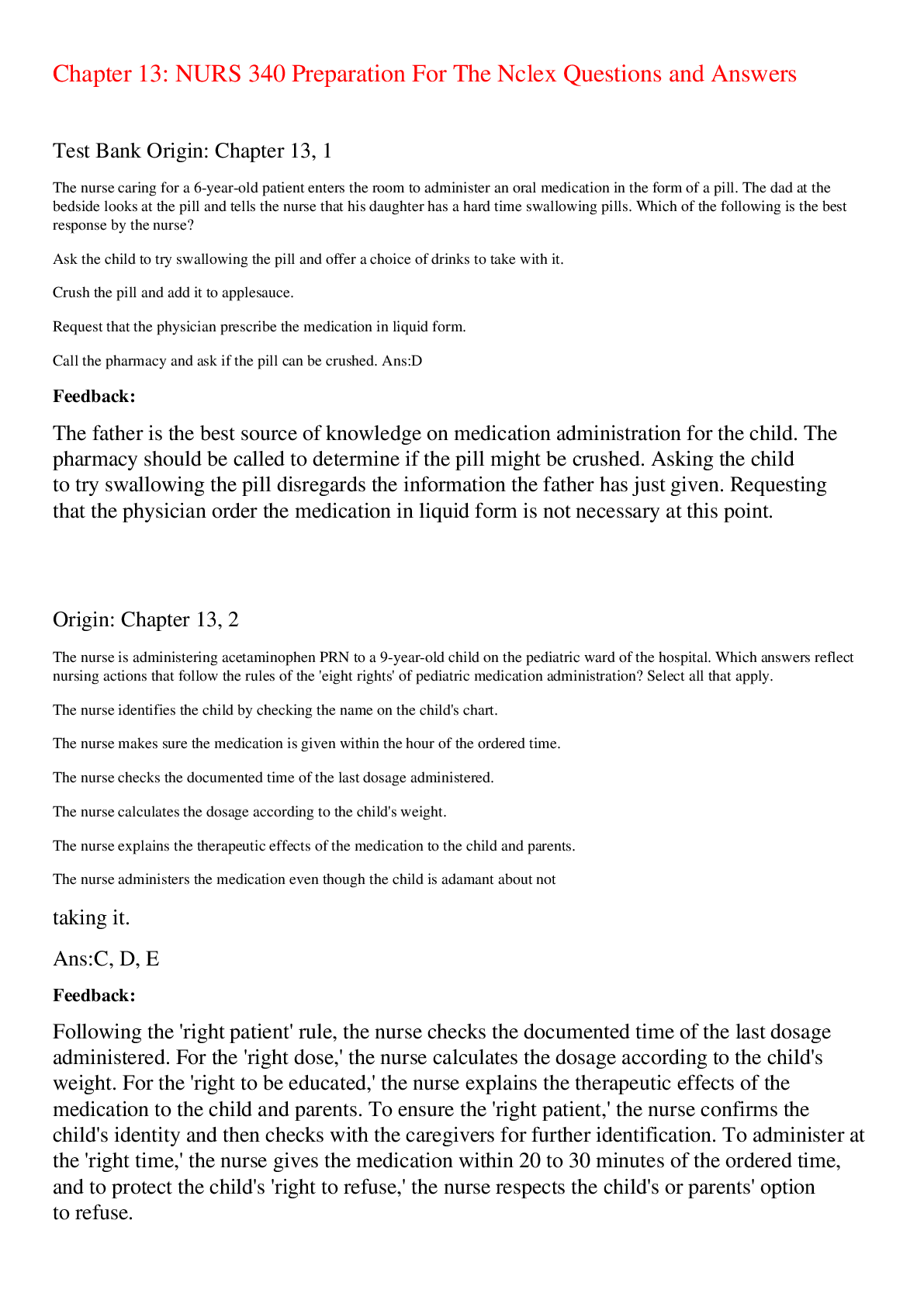
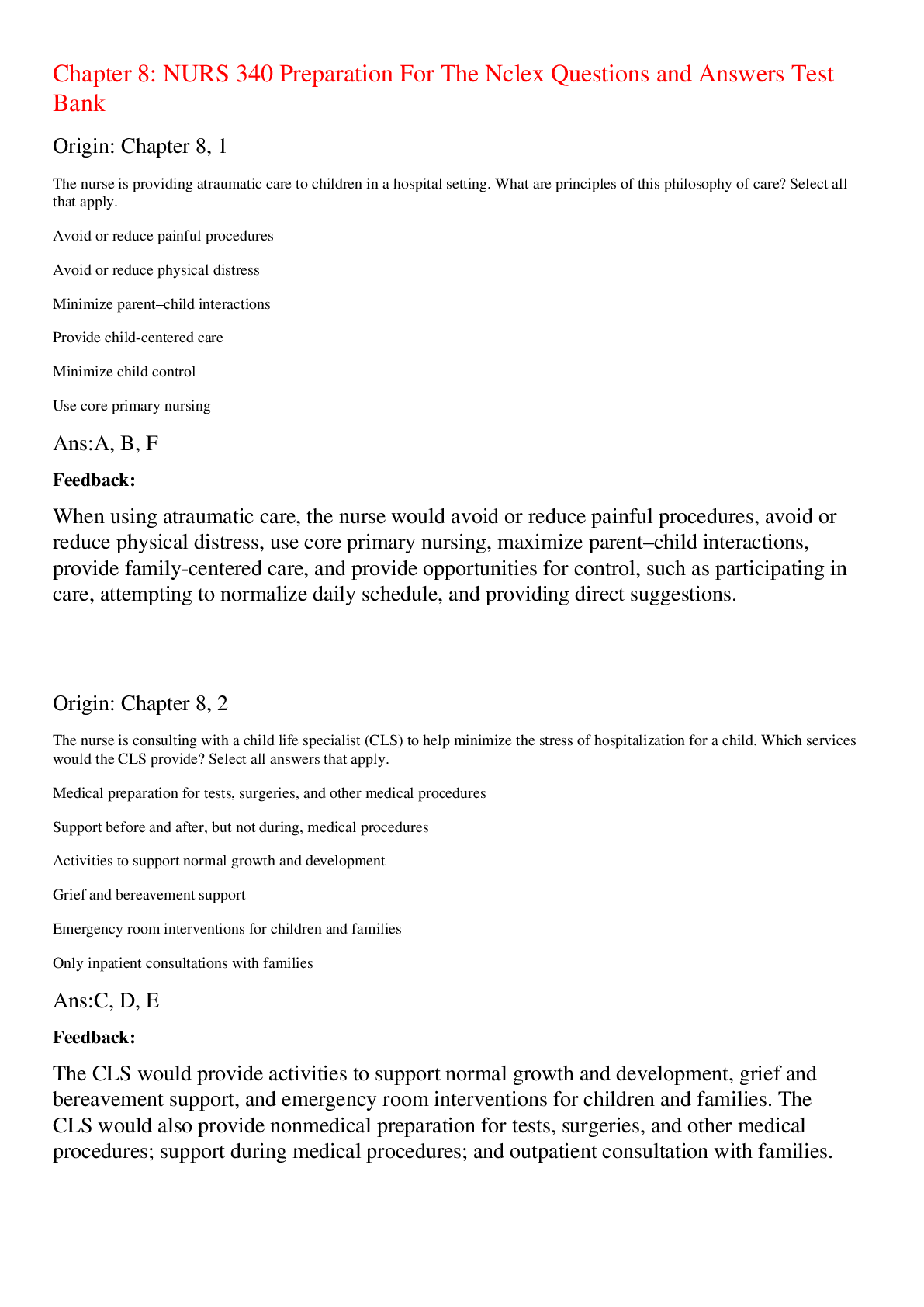

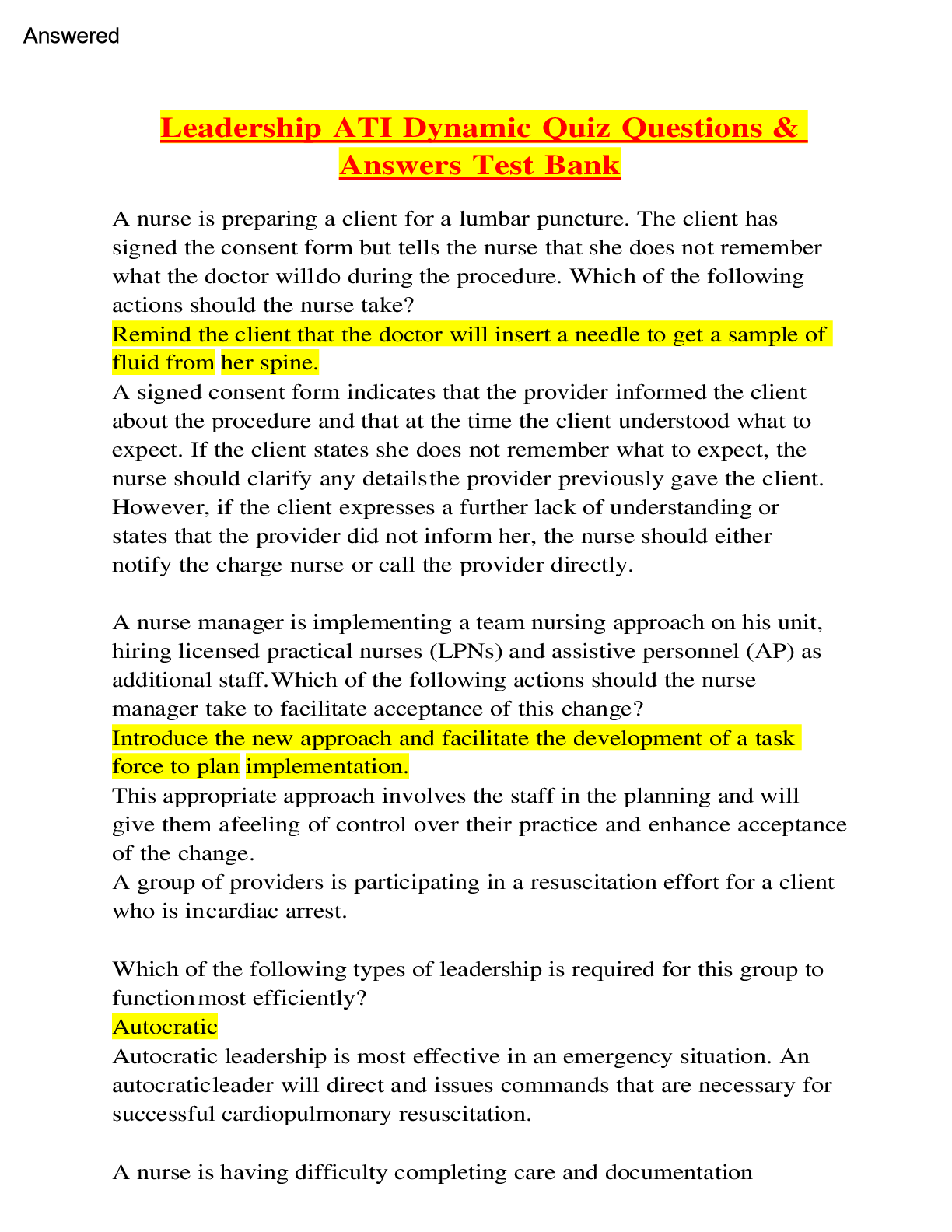
 (1).png)
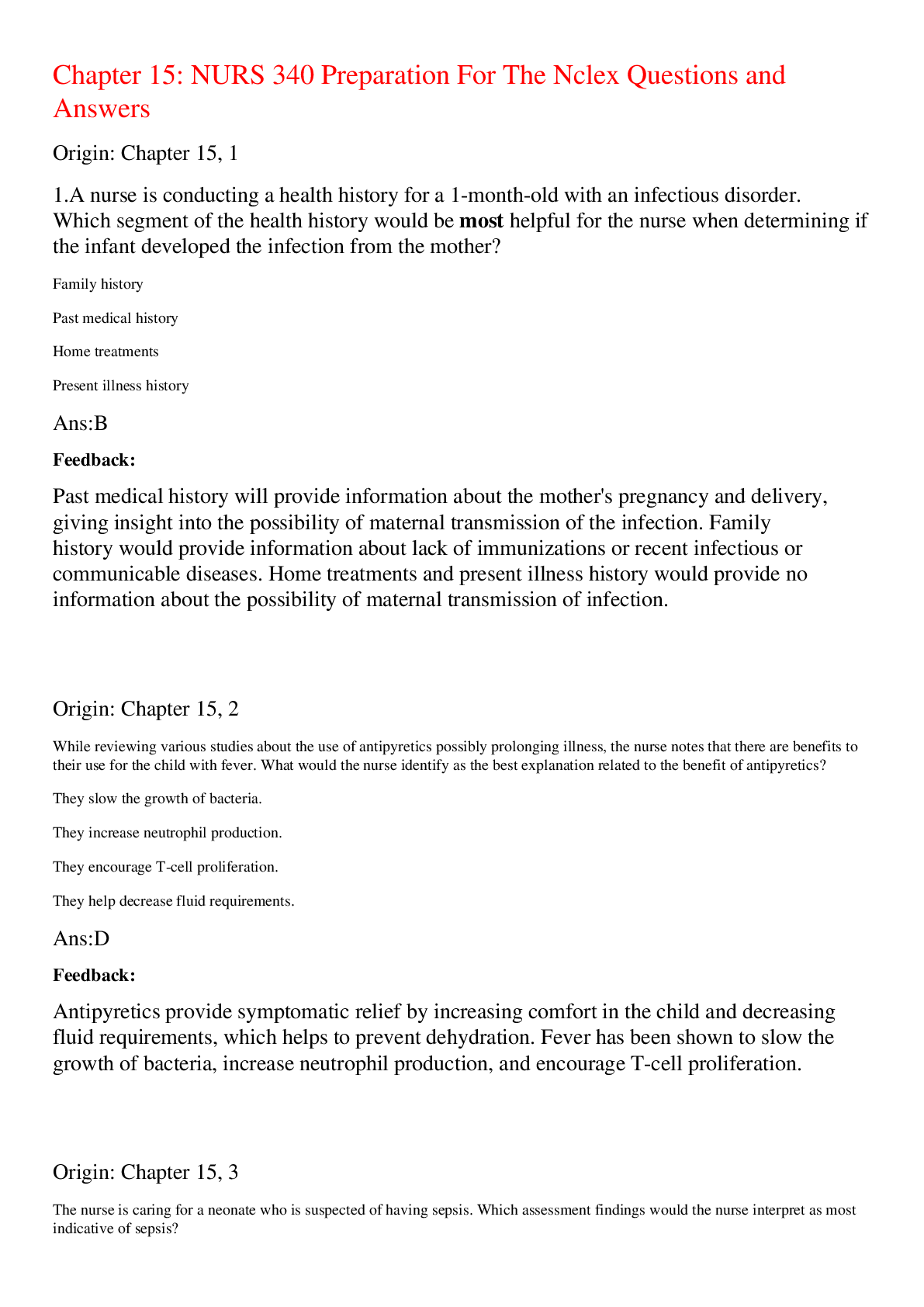

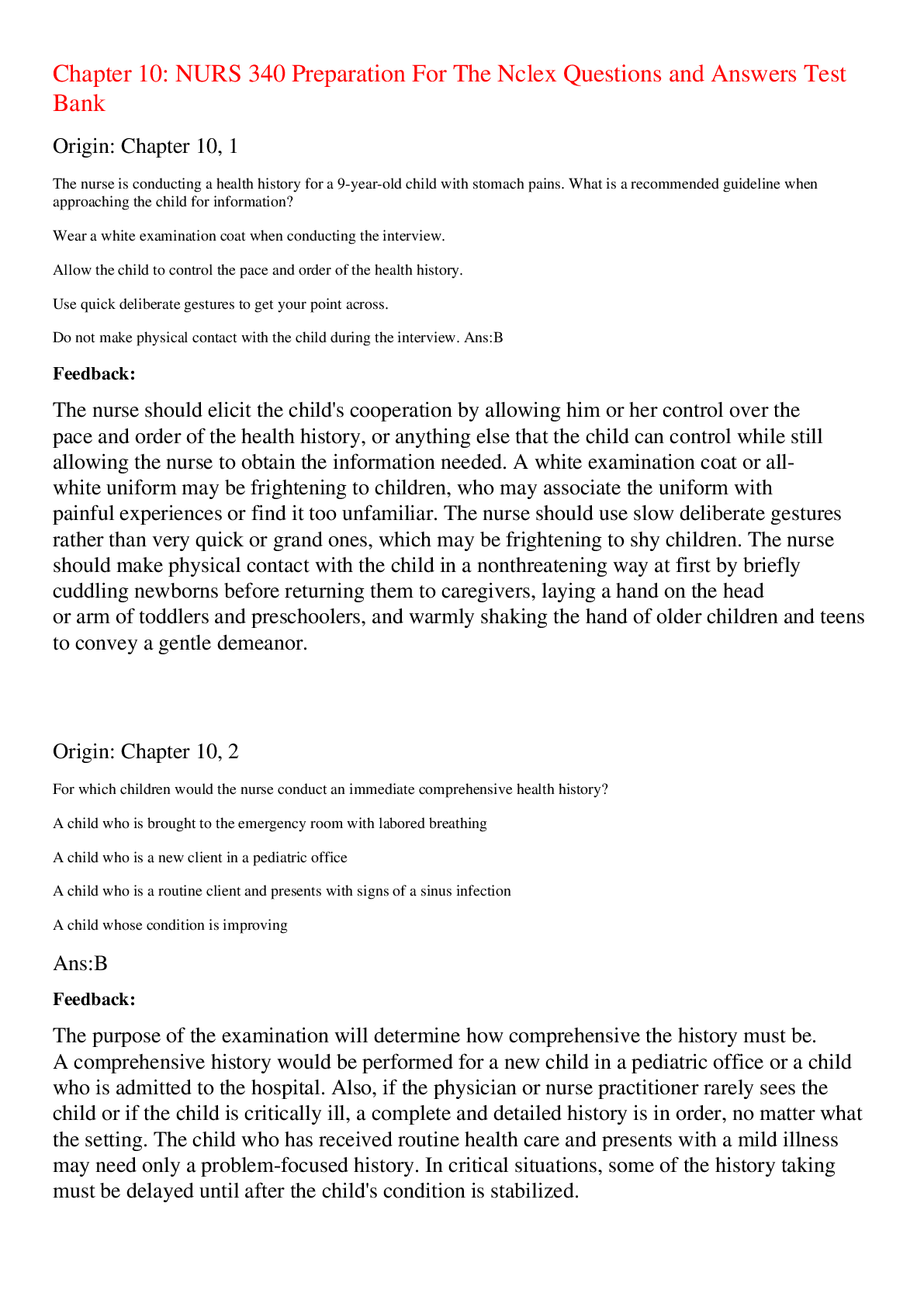

.png)
